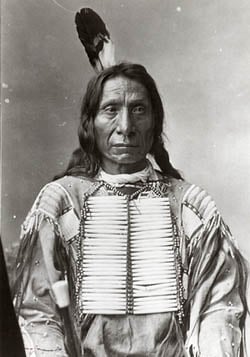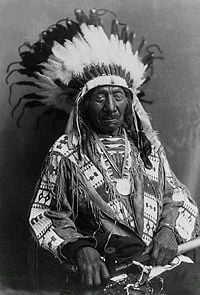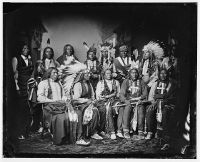Red Cloud
- For other uses, see Red Cloud (disambiguation).
| Red Cloud | |
 | |
| Born | Makhpiya Luta 1822 near North Platte, Nebraska |
|---|---|
| Died | December 10, 1909 |
| Known for | Red Cloud's War |
Red Cloud (Lakota: Makhpiya Luta), (1822 – December 10, 1909) was a war leader of the Oglala Lakota (Sioux). One of the most capable Native American opponents the U. S. military ever faced, he led a successful conflict in 1866–1868 known as Red Cloud's War over control of the Powder River Country in northwestern Wyoming and southern Montana. Later, he led his people in reservation life.
Early life
Red Cloud was born close to the forks of the Platte River by the modern-day city of North Platte, Nebraska. His mother was an Oglala and his father was a Brulé. Red Cloud was partly raised by his maternal uncle, Chief Smoke. At a young age, he fought against neighboring Pawnee and Crow, gaining much military experience.
Red Cloud's War
- Main article: Red Cloud's War
In an 1851 treaty at Fort Laramie, the Sioux (among other tribes) had agreed on terms by which the United States might establish limited roads and military posts on Indian land. [1] By 1865, Red Cloud was one of many Indian leaders who believed the U.S. was breaking the treaty by establishing forts too far up the Bozeman Trail. They had seen other tribes expelled from their land and were determined to resist.
In June 1865 Red Cloud's Sioux joined a coalition led by Woqini (Roman Nose) of the Cheyenne to attack a military post on the North Platte River. Believing they had taught the bluecoats to respect the treaty, they returned home only to learn in August of further encroachments. The U.S. Army was constructing forts along the Bozeman Trail straight through Lakota territory (modern-day Wyoming), from the South Platte River in Colorado to Montana's gold country. Red Cloud foresaw the eventual expulsion of the Lakota from their land.
In 1866, he began what has come to be known as Red Cloud's War, the most successful war an Indian nation ever waged against the U.S. military. He achieved several victories, resulting in a new Treaty of Fort Laramie by which the U.S. abandoned all forts on the Bozeman Trail and acknowledged Lakota possession of what is now the Western half of South Dakota, including the Black Hills, and much of Montana and Wyoming.
The Treaty of 1868
Uneasy relations between the expanding United States and the natives continued. In 1871, Red Cloud visited Washington D.C., and met with Commissioner of Indian Affairs Ely S. Parker and President Ulysses Grant. In 1871, the Red Cloud Agency was established on the Platte River, downstream from Fort Laramie. As outlined in the Treaty of 1868, the agency staff were responsible for issuing rations to the Lakota weekly as well as providing the annual annuity goods. In the fall of 1873, the agency was removed to the upper White River in northwestern Nebraska.
The Great Sioux War of 1876-77
Red Cloud settled at the agency with his band by the fall of 1873. He soon became embroiled in a controversy with the new Indian agent, Dr. John J. Saville.
In 1874, General George Armstrong Custer led a reconnaissance mission into Sioux territory that reported gold in the Black Hills, a sacred area to the Indians. Formally, the Army tried to keep miners out but did not succeed; the threat of violence grew. Red Cloud, along with other leaders, rejected a treaty ceding the territory; he was unsuccessful in finding a peaceful solution, and did not take part in the Lakota war of 1876-1877 led by T‘ašunka Witko (Crazy Horse) and Tatanka Iyotake (Sitting Bull).
In the fall of 1877, the Red Cloud Agency was removed to the Missouri River and the following year, removed to the forks of the White River where it was renamed the Pine Ridge Reservation.
His last days
Red Cloud continued fighting for his people, even after being forced onto the reservation. In 1889 he opposed a treaty to sell more of the Sioux land; his steadfastness and that of Sitting Bull required the government agents to obtain the necessary signatures through subterfuges such as obtaining the signatures of children. He negotiated strongly with Indian agents such as Dr. Valentine McGillycuddy, and opposed the Dawes Act.
Red Cloud became an important leader of the Lakota as they transitioned from the freedom of the plains to the confinement of the reservation system. He outlived the other major Sioux leaders of the Indian wars and died in 1909 at the age of 87 on the Pine Ridge Reservation, where he is buried.
He was never part of the Ghost Dance movement.
Notes
- ↑ *Brown, Dee (1970). Bury My Heart at Wounded Knee, ch. 6. Bantam Books. ISBN 0-553-11979-6.
ReferencesISBN links support NWE through referral fees
External links
All links Retrieved April 30, 2008.
Credits
New World Encyclopedia writers and editors rewrote and completed the Wikipedia article in accordance with New World Encyclopedia standards. This article abides by terms of the Creative Commons CC-by-sa 3.0 License (CC-by-sa), which may be used and disseminated with proper attribution. Credit is due under the terms of this license that can reference both the New World Encyclopedia contributors and the selfless volunteer contributors of the Wikimedia Foundation. To cite this article click here for a list of acceptable citing formats.The history of earlier contributions by wikipedians is accessible to researchers here:
The history of this article since it was imported to New World Encyclopedia:
Note: Some restrictions may apply to use of individual images which are separately licensed.

